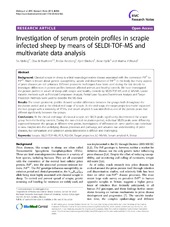| dc.contributor.author | Meling, Siv | eng |
| dc.contributor.author | Kvalheim, Olav Martin | eng |
| dc.contributor.author | Arneberg, Reidar | eng |
| dc.contributor.author | Bårdsen, Kjetil | eng |
| dc.contributor.author | Hjelle, Anne | eng |
| dc.contributor.author | Ulvund, Martha J. | eng |
| dc.date.accessioned | 2013-12-09T08:47:24Z | |
| dc.date.available | 2013-12-09T08:47:24Z | |
| dc.date.issued | 2013-11-14 | eng |
| dc.Published | BMC Research Notes 6(1):466 | eng |
| dc.identifier.issn | 1756-0500 | en_US |
| dc.identifier.uri | https://hdl.handle.net/1956/7580 | |
| dc.description.abstract | Background: Classical scrapie in sheep is a fatal neurodegenerative disease associated with the conversion PrPC to PrPSc. Much is known about genetic susceptibility, uptake and dissemination of PrPSc in the body, but many aspects of prion diseases are still unknown. Different proteomic techniques have been used during the last decade to investigate differences in protein profiles between affected animals and healthy controls. We have investigated the protein profiles in serum of sheep with scrapie and healthy controls by SELDI-TOF-MS and LC-MS/MS. Latent Variable methods such as Principal Component Analysis, Partial Least Squares-Discriminant Analysis and Target Projection methods were used to describe the MS data. Results: The serum proteomic profiles showed variable differences between the groups both throughout the incubation period and at the clinical end stage of scrapie. At the end stage, the target projection model separated the two groups with a sensitivity of 97.8%, and serum amyloid A was identified as one of the protein peaks that differed significantly between the groups. Conclusions: At the clinical end stage of classical scrapie, ten SELDI peaks significantly discriminated the scrapie group from the healthy controls. During the non-clinical incubation period, individual SELDI peaks were differently expressed between the groups at different time points. Investigations of differences in -omic profiles can contribute to new insights into the underlying disease processes and pathways, and advance our understanding of prion diseases, but comparison and validation across laboratories is difficult and challenging. | en_US |
| dc.language.iso | eng | eng |
| dc.publisher | BioMed Central Ltd. | en_US |
| dc.rights | Attribution CC BY | eng |
| dc.rights.uri | http://creativecommons.org/licenses/by/2.0 | eng |
| dc.subject | Scrapie | eng |
| dc.subject | SELDI-TOF-MS | eng |
| dc.subject | PCA | eng |
| dc.subject | PLS-DA | eng |
| dc.subject | Target projection | eng |
| dc.subject | LC-MS/MS | eng |
| dc.subject | Serum amyloid A | eng |
| dc.subject | Sheep | eng |
| dc.title | Investigation of serum protein profiles in scrapie infected sheep by means of SELDI-TOF-MS and multivariate data analysis | en_US |
| dc.type | Peer reviewed | |
| dc.type | Journal article | |
| dc.date.updated | 2013-11-25T16:07:31Z | |
| dc.description.version | Peer Reviewed | |
| dc.description.version | publishedVersion | en_US |
| dc.rights.holder | Siv Meling et al.; licensee BioMed Central Ltd. | en_US |
| dc.rights.holder | Copyright 2013 Meling et al.; licensee BioMed Central Ltd. | en_US |
| dc.identifier.doi | https://doi.org/10.1186/1756-0500-6-466 | |
| dc.identifier.cristin | 1097691 | |

